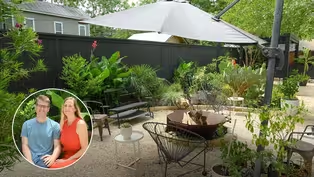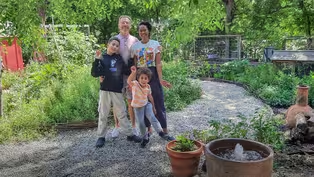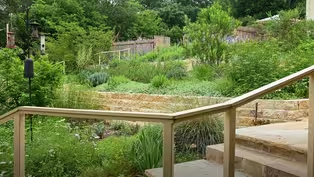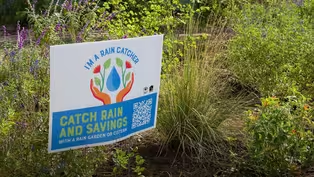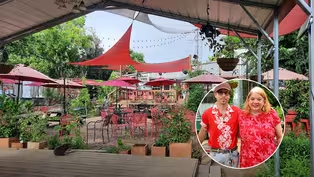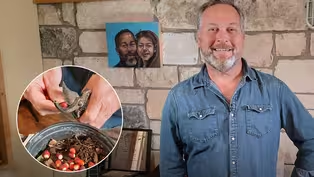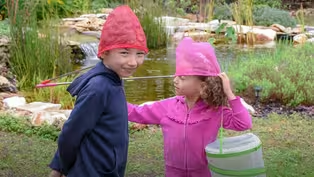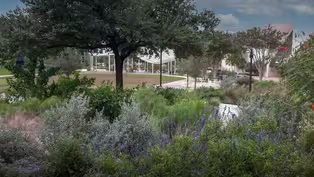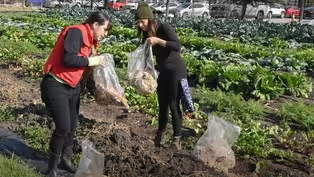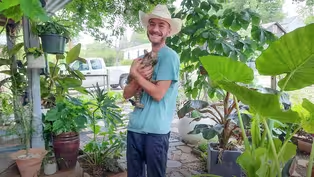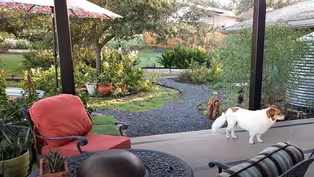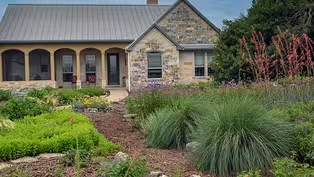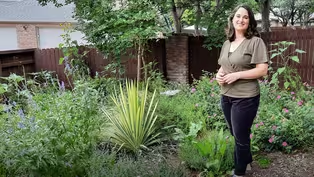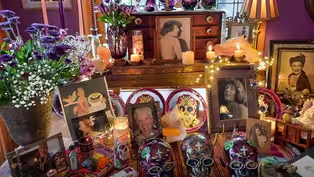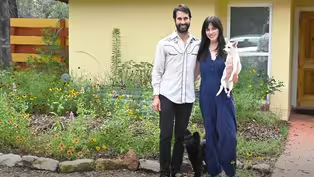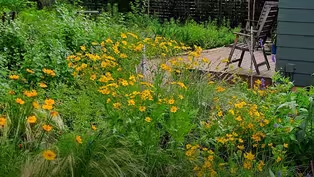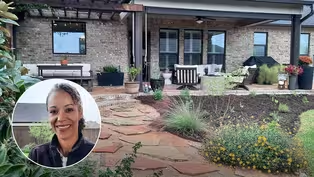
Less Lawn, More Wildlife, Lessons Learned
Clip: Season 29 | 9m 23sVideo has Closed Captions
Natalie McAnarney’s family spends more time in the backyard since she swapped dull for enchanting.
Natalie McAnarney’s family spends a lot more time in their backyard since she took a hard look at its stark fence and lawn. Initially, she wanted a pretty garden. Then she graduated to beautiful plants that work in Texas weather. When pollinators and birds arrived, she found a mission that extends far beyond her yard.
Problems playing video? | Closed Captioning Feedback
Problems playing video? | Closed Captioning Feedback
Central Texas Gardener is a local public television program presented by Austin PBS
Support for CTG is provided by: Lisa & Desi Rhoden, and Diane Land & Steve Adler. Central Texas Gardener is produced by Austin PBS, KLRU-TV and distributed by NETA.

Less Lawn, More Wildlife, Lessons Learned
Clip: Season 29 | 9m 23sVideo has Closed Captions
Natalie McAnarney’s family spends a lot more time in their backyard since she took a hard look at its stark fence and lawn. Initially, she wanted a pretty garden. Then she graduated to beautiful plants that work in Texas weather. When pollinators and birds arrived, she found a mission that extends far beyond her yard.
Problems playing video? | Closed Captioning Feedback
How to Watch Central Texas Gardener
Central Texas Gardener is available to stream on pbs.org and the free PBS App, available on iPhone, Apple TV, Android TV, Android smartphones, Amazon Fire TV, Amazon Fire Tablet, Roku, Samsung Smart TV, and Vizio.
Providing Support for PBS.org
Learn Moreabout PBS online sponsorship- Initially, I wanted just things to be pretty and then I wanted it to be pretty and sustainable.
And then eventually, I got to the place where I wanted to support the wildlife.
My name is Natalie McAnarney and I have been in Central Texas for a while, left and came back.
We bought this house in 2019, and it was kind of a builder grade yard, and so we didn't have a whole lot of money to fix it up right away.
So we kind of took it in phases, and I really wanted to create a space where it was appealing and kind of drew you outside, but also something that was practical, a place where I could grow my own fruits and vegetables.
And eventually, I would really love to reduce my lawn size 'cause right now, there's a ton of lawn.
So I've still got, I think, a long way to go.
The first thing I did was extend the patio because we really enjoy being outside.
And somewhere along the way somebody told me, "Start with your hardscape first 'cause it really changes how water moves and it might change really what options you have for plants.
The next thing I did was we added the vegetable garden.
And so I did kill all the grass, and then we put in a few raised beds, just like two small raised beds.
They looked like two coffins for a little while.
And then you're like, "Well, this is great for the growing season but now it's cold, and I still wanna do things.
And so then we added a greenhouse, and then the greenhouse fell apart in three years.
And so then I have fixed that.
And then the more you're out here, the more you wanna enjoy it.
Then I started to just create an enclosure.
I think that was my goal.
I wanted it to feel like a big hug.
And so I started along the fence line and then I kind of have been slowly working my way around the patio, trying to create layers of interest but also just sort of that enclosure.
I also have a desert willow, which has been a superstar.
I mean, everything loves it.
Bees love it, wasps love it, hummingbirds love it, I love it.
It did not skip a beat in this heat.
Initially, I laid a bunch of weed barrier down, and then every time I try to put a new plant in there, I'm kicking myself 'cause I've gotta dig through all that weed barrier, and guess what?
The weeds still grow.
So now I've taken it using solarization.
It is a slow process and it's not always super effective, but that's how I kill my grass now.
And then I think there's even sheet mulching that you can do.
There's other techniques.
I have St. Augustine, which if you rake it away, it's okay, but some of that Bermuda, I mean you gotta get after it to really keep it from coming up in your garden bed, which would make me crazy.
I kind of created the landscaping around along the edge of the fence and it kind of is wavy.
I like that curvilinear pattern.
I just feel like it's just soothing to the eye.
I've edged it with a Victorian trench, and so that's an edging technique where you create an invisible border but you do slope.
It's about six inches deep, but you do slope the ground a bit.
One of the benefits I think of that Victorian trench is that you can direct water away.
You can actually grade it to where it's maybe a little bit deeper on one side of the garden bed.
And so the water will tend to flow that way so you can kind of manage your water a little bit better, especially after a heavy rain.
I really like that natural border between the grass and the mulch.
I have border-like stone border and steel border and other places where I really struggle to keep the different media from mixing, like with granite and rock.
Have a really hard time keeping granite in play or rock in place.
And so I've used stone border for that.
I have two rain barrels and one of the rain barrels is off my covered patio and the excess will drain off onto a small rocky area and then gets dumped into that Victorian trench and then down to sort of a dry creek bed with a bunch of rocks and it sort of sets in a low spot in my garden.
But then the water seems to absorb just fine.
I think the first thing, when I started to put plants in, I wanted something that would be nice all year or that gave me interest all year.
So I really let the evergreens kind of be the bones, and then I sort of worked around that.
And I will have to say, I kind of used to just go to the big box store, and I don't mind a big box store.
They're great for a lot of things, but they really didn't have a lot that was well suited for the area and I learned that the hard way.
So I had a lot of things just not make it through summer or through winter.
And so then as I began to just look at gardens that were doing really well, I realized that they did well because they had a lot of native and well-adapted plants.
And so then I slowly started working those into the garden and sometimes it looks a bit like a hodgepodge, but I don't mind.
And so I've been filling those empty spots where I don't have evergreens with native perennials primarily.
That's a challenging spot right there because it gets a lot of shade but it gets enough sun that they did struggle a little bit with the heat.
But the crossvine, I mean even though it's in a planter, it's totally fine.
Even in the winter, it doesn't die back or anything.
I also have a Little Gem magnolia, and I love that tree so much because it does offer all-year interest, and then the beautiful blooms in the spring.
And I had no idea that magnolias, flowers had a smell but they smell really nice.
They're so pretty.
Recently, I was introduced to Doug Tallamy, and he has this Homegrown National Park.
So I put myself on that map and you can do that.
And I set a goal for myself, but he talks a lot about putting plants in that create food, and a habitat for the food web, and how important that is.
And I think when you're in the garden, you start to see all the little critters come out and you're like, "Well, I wanna do that too."
So I've done away with my pest guy now, and I'm working on trying to do some other things.
It's that kind of a journey, and I think a lot of people go take that.
I just want something pretty all the way to now I'm trying to support the food web.
(Natalie laughing) I do feel as a gardener that I have some degree of responsibility of doing this well because it impacts the food web beyond my yard.
I do know that.
And so I definitely want to learn more about how to just steward what I have here in a way that doesn't harm that food web at all.
And I will say that I knew I had become a gardener when the sound of bees no longer scared me but made me happy.
And so then I just wanted to make life easy for them, the bees, the butterflies, the birds because just sitting out here is such an oasis away from just that busy life, and it's a way to be off of all the screens and it's very grounding to watch them.
So I guess I'm being selfish 'cause I just wanna watch them do their thing.
And so gardening provides a great opportunity for people to really just stop and slow down, which is what we need.
I'm an anxious person myself and I get it.
So it's an opportunity to stop and slow down.
There may be some added benefits in the soil.
And then it's time away from that screen, which I'm sure will, as we go along with tech, we're probably only scratching the surface as to how that really affects us.
I don't think it's all bad by any means, but I think you gotta put some limits on it.
If you can find the thing that pulls you away from kind of living that ever-productive, I gotta be productive, productive, productive, it's good for you.
So I think gardening is really just good for a lot of us, and especially if you're an anxious person because I think it creates this sort of optimism in you because you don't just see what's there, you see things for how they could be.
And watching that come to fruition, it's magical, and it's just encouraging.
So I think gardening for me has really brought that, has made me sort of this optimist.
And so in a world where I feel like we get a lot of bad news, and you see beyond that, and it just gives you hope for seeing how things could be.
Contemporary Courtyard Makeover
Video has Closed Captions
Clip: S29 | 9m 29s | In a ground-level makeover, a young couple went for outdoor living and wildlife habitat. (9m 29s)
Blank Yard to Wonder-Filled Gardens
Video has Closed Captions
Clip: S29 | 8m 54s | Richie and Nkiru Gelles applied muscle and imagination to turn their backyard into a lively habitat. (8m 54s)
Garden Design: Plant Communities for Wildlife
Video has Closed Captions
Clip: S29 | 9m 27s | On an old lot, new owners envisioned an urban wildlife sanctuary for year-round beauty. (9m 27s)
Rain Gardens: Catch and Hold Runoff Water
Video has Closed Captions
Clip: S29 | 7m 55s | See how to create a rain garden with beautiful native and adapted plants for pollinators. (7m 55s)
Butterfly Garden Performs at Repertory Theater
Video has Closed Captions
Clip: S29 | 9m 14s | An urban butterfly sanctuary restores life to soil and soul in daily pollinator performances. (9m 14s)
Easy Way to Germinate Texas Mountain Laurel Seeds
Video has Closed Captions
Clip: S29 | 3m 40s | Get the secret to success with Billy Garza. (3m 40s)
Music to Your Ears: Food, Fun, Family
Video has Closed Captions
Clip: S29 | 7m 37s | Musicians and home-schoolers Lisa and Shane Lamb grow their garden goals one weekend at a time. (7m 37s)
Parking Lot to Wildlife Habitat Park: St. John Encampment
Video has Closed Captions
Clip: S29 | 8m 22s | Once crowded with cars, this former mall parking lot now gathers another kind of community (8m 22s)
Grow Soil Health with Mushroom Blocks
Video has Closed Captions
Clip: S29 | 4m 35s | Smash and mulch recycled mushroom blocks for healthy, productive plants. (4m 35s)
Garden Love Germinates at Rental House
Video has Closed Captions
Clip: S29 | 7m 44s | Cyrano Carroll wasn’t keen on digging in until a chance opportunity changed his life. (7m 44s)
Video has Closed Captions
Clip: S29 | 9m 17s | Kat and Dave Sherby fell for a big yard that beckoned creative brainstorming for wildlife watching. (9m 17s)
From Cattle Ranch to Wildlife Paradise
Video has Closed Captions
Clip: S29 | 8m 42s | These days, wildlife graze four acres of native plant gardens on former ranchland in Jarrell. (8m 42s)
Drought-tough Cottage Design with Native Plants
Video has Closed Captions
Clip: S29 | 8m 11s | Alexa Volpe never knew that gardening could be so hard until moving to rocky soil in San Antonio. (8m 11s)
How Biking Led to No Lawn Native Plants
Video has Closed Captions
Clip: S29 | 8m 43s | Biking along country roads inspired Laura O’Toole to rip out lawn for beautiful native plants. (8m 43s)
Celebrating Life on Day of the Dead
Video has Closed Captions
Clip: S29 | 8m 11s | Dia de Los Muertos pays tribute to our lost loved ones who influenced our lives, souls, and culture. (8m 11s)
Small Yard Makeover: From Grass to Wildlife Diversity
Video has Closed Captions
Clip: S29 | 9m 30s | Ecologist and mycologist Chris Garza controlled flooding rain and restored the soil in a small yard. (9m 30s)
Three Stories of Change: Wildflower Pocket Gardens
Video has Closed Captions
Clip: S29 | 9m 23s | Pollinators and birds waltz around native plants where lawn grass once dominated. (9m 23s)
Less Lawn, More Wildlife, Lessons Learned
Video has Closed Captions
Clip: S29 | 9m 23s | Natalie McAnarney’s family spends more time in the backyard since she swapped dull for enchanting. (9m 23s)
Providing Support for PBS.org
Learn Moreabout PBS online sponsorship

- Home and How To

Hit the road in a classic car for a tour through Great Britain with two antiques experts.












Support for PBS provided by:
Central Texas Gardener is a local public television program presented by Austin PBS
Support for CTG is provided by: Lisa & Desi Rhoden, and Diane Land & Steve Adler. Central Texas Gardener is produced by Austin PBS, KLRU-TV and distributed by NETA.
